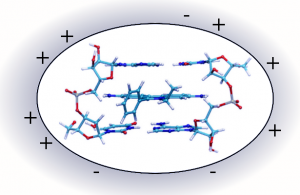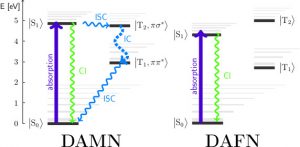slider
Linear and nonlinear optical properties of molecular systems
W. Bartkowiak, R.W. Góra, J. Kozłowska, A. Roztoczyńska, K. Strasburger, R. Zaleśny
One of the main research topics in our group are linear and nonlinear electro-optic properties of molecules and molecular aggregates, as well as the influence of external confining potentials on these properties. Our research interests focus on theory and computations of electronic and vibrational (hyper)polarizabilities, simulations of multiphoton absorption in organic compounds, electronic structure and properties of π-conjugated systems, interaction-induced (hyper)polarizabilities of molecular clusters and theory and computations of solvent effects on molecular properties.
415588
{415588:949SVMJY},{415588:G46VRHRJ},{415588:AJVQS976},{415588:96985HZZ},{415588:XHNQ8HTQ},{415588:7RVU26XD},{415588:32GQL3KA},{415588:UWEUEM38},{415588:8QX2Y5RS}
royal-society-of-chemistry-with-titles
50
date
1
836
https://huckel.pl/wp-content/plugins/zotpress/
%7B%22status%22%3A%22success%22%2C%22updateneeded%22%3Afalse%2C%22instance%22%3A%22zotpress-a88a0f93491dbe5b50145f727dc30c4e%22%2C%22meta%22%3A%7B%22request_last%22%3A0%2C%22request_next%22%3A0%2C%22used_cache%22%3Atrue%7D%2C%22data%22%3A%5B%7B%22key%22%3A%22949SVMJY%22%2C%22library%22%3A%7B%22id%22%3A415588%7D%2C%22meta%22%3A%7B%22creatorSummary%22%3A%22Koz%5Cu0142owska%20et%20al.%22%2C%22parsedDate%22%3A%222019-08-07%22%2C%22numChildren%22%3A5%7D%2C%22bib%22%3A%22%3Cdiv%20class%3D%5C%22csl-bib-body%5C%22%20style%3D%5C%22line-height%3A%201.35%3B%20%5C%22%3E%5Cn%20%20%3Cdiv%20class%3D%5C%22csl-entry%5C%22%20style%3D%5C%22clear%3A%20left%3B%20%5C%22%3E%5Cn%20%20%20%20%3Cdiv%20class%3D%5C%22csl-left-margin%5C%22%20style%3D%5C%22float%3A%20left%3B%20padding-right%3A%200.5em%3B%20text-align%3A%20right%3B%20width%3A%201em%3B%5C%22%3E1%3C%5C%2Fdiv%3E%3Cdiv%20class%3D%5C%22csl-right-inline%5C%22%20style%3D%5C%22margin%3A%200%20.4em%200%201.5em%3B%5C%22%3EJ.%20Koz%26%23x142%3Bowska%2C%20P.%20Lipkowski%2C%20A.%20Roztoczy%26%23x144%3Bska%20and%20W.%20Bartkowiak%2C%20DFT%20and%20spatial%20confinement%3A%20a%20benchmark%20study%20on%20the%20structural%20and%20electrical%20properties%20of%20hydrogen%20bonded%20complexes%2C%20%3Ci%3EPhys.%20Chem.%20Chem.%20Phys.%3C%5C%2Fi%3E%2C%202019%2C%20%3Cb%3E21%3C%5C%2Fb%3E%2C%2017253%26%23x2013%3B17273.%20%3Ca%20title%3D%27Cite%20in%20RIS%20Format%27%20class%3D%27zp-CiteRIS%27%20href%3D%27https%3A%5C%2F%5C%2Fhuckel.pl%5C%2Fwp-content%5C%2Fplugins%5C%2Fzotpress%5C%2Flib%5C%2Frequest%5C%2Frequest.cite.php%3Fapi_user_id%3D415588%26amp%3Bitem_key%3D949SVMJY%27%3ECite%3C%5C%2Fa%3E%20%3C%5C%2Fdiv%3E%5Cn%20%20%3C%5C%2Fdiv%3E%5Cn%3C%5C%2Fdiv%3E%22%2C%22data%22%3A%7B%22itemType%22%3A%22journalArticle%22%2C%22title%22%3A%22DFT%20and%20spatial%20confinement%3A%20a%20benchmark%20study%20on%20the%20structural%20and%20electrical%20properties%20of%20hydrogen%20bonded%20complexes%22%2C%22creators%22%3A%5B%7B%22creatorType%22%3A%22author%22%2C%22firstName%22%3A%22Justyna%22%2C%22lastName%22%3A%22Koz%5Cu0142owska%22%7D%2C%7B%22creatorType%22%3A%22author%22%2C%22firstName%22%3A%22Pawe%5Cu0142%22%2C%22lastName%22%3A%22Lipkowski%22%7D%2C%7B%22creatorType%22%3A%22author%22%2C%22firstName%22%3A%22Agnieszka%22%2C%22lastName%22%3A%22Roztoczy%5Cu0144ska%22%7D%2C%7B%22creatorType%22%3A%22author%22%2C%22firstName%22%3A%22Wojciech%22%2C%22lastName%22%3A%22Bartkowiak%22%7D%5D%2C%22abstractNote%22%3A%22An%20extended%20set%20of%2037%20exchange%20correlation%20functionals%2C%20representing%20different%20DFT%20approximations%2C%20has%20been%20evaluated%20on%20a%20difficult%20playground%20represented%20by%20the%20dipole%20moment%20%28%5Cu03bcz%29%2C%20polarizability%20%28%5Cu03b1zz%29%2C%20first%20hyperpolarizability%20%28%5Cu03b2zzz%29%2C%20and%20the%20corresponding%20interaction-induced%20electrical%20properties%20%28%5Cu0394%5Cu03bcz%2C%20%5Cu0394%5Cu03b1zz%2C%20%5Cu0394%5Cu03b2zzz%29%20of%20spatially%20confined%20hydrogen%20bonded%20%28HB%29%20dimers.%20A%20two-dimensional%20harmonic%20oscillator%20potential%20was%20used%20to%20exert%20the%20effect%20of%20spatial%20restriction.%20The%20performance%20of%20DFT%20methods%20in%20predicting%20hydrogen%20bond%20lengths%20in%20the%20studied%20molecular%20complexes%20upon%20confinement%20has%20also%20been%20examined.%20The%20data%20determined%20using%20a%20high-level%20CCSD%28T%29%20method%20serve%20as%20a%20reference.%20The%20conducted%20analyses%20allow%20us%20to%20conclude%20that%20methods%20rooted%20in%20DFT%20constitute%20a%20precise%20tool%20for%20the%20calculation%20of%20%5Cu03bcz%20and%20%5Cu03b1zz%20as%20well%20as%20%5Cu0394%5Cu03bcz%20and%20%5Cu0394%5Cu03b1zz%2C%20as%20most%20of%20the%20tested%20functionals%20provide%20results%20affected%20by%20rather%20small%20relative%20errors.%20On%20the%20other%20hand%2C%20an%20accurate%20description%20of%20the%20nonlinear%20optical%20response%20of%20the%20studied%20HB%20systems%20remains%20a%20great%20challenge%20for%20most%20of%20the%20analyzed%20DFT%20functionals%2C%20both%20in%20vacuum%20and%20in%20the%20presence%20of%20an%20analytical%20confining%20potential.%20Some%20of%20the%20tested%20DFT%20methods%20are%20found%20to%20be%20prone%20to%20catastrophic%20failure%20in%20the%20prediction%20of%20%5Cu03b2zzz%20as%20well%20as%20%5Cu0394%5Cu03b2zzz.%20The%20obtained%20results%20indicate%20that%20there%20is%20no%20great%20chasm%20in%20performance%20between%20functionals%20belonging%20to%20different%20DFT%20approximations%20or%20functionals%20including%20different%20amount%20of%20Hartree%5Cu2013Fock%20exchange%20when%20the%20values%20of%20dipole%20moment%20and%20first%20hyperpolarizability%20as%20well%20as%20the%20corresponding%20interaction-induced%20electrical%20properties%20are%20considered.%20However%2C%20a%20higher%20fraction%20of%20Hartree%5Cu2013Fock%20exchange%20improves%20the%20quality%20of%20predictions%20of%20%5Cu03b1zz%20and%20%5Cu0394%5Cu03b1zz.%20Additionally%2C%20it%20has%20been%20shown%20that%20only%20three%20functionals%20from%20the%20examined%20set%2C%20namely%20B2PLYP%2C%20B3LYP%20and%20%5Cu03c9B97X-D%2C%20provide%20highly%20accurate%20structural%20parameters%20for%20the%20investigated%20systems.%20Of%20significant%20importance%20is%20the%20conclusion%20that%20the%20%5Cu03c9B97X-D%20functional%2C%20representing%20a%20modern%20and%20highly%20parametrized%20range-separated%20hybrid%2C%20demonstrates%20the%20most%20coherent%20behavior%2C%20showing%20rather%20small%20deviations%20from%20the%20reference%20data%20in%20the%20case%20of%20%5Cu03bcz%2C%20%5Cu03b1zz%2C%20%5Cu0394%5Cu03bcz%20and%20%5Cu0394%5Cu03b1zz%20as%20well%20as%20the%20structural%20parameters%20of%20the%20studied%20HB%20dimers.%20Moreover%2C%20our%20results%20indicate%20that%20the%20presence%20of%20spatial%20confinement%20has%20a%20rather%20small%20effect%20on%20the%20performance%20of%20DFT%20methods.%22%2C%22date%22%3A%222019-08-07%22%2C%22language%22%3A%22en%22%2C%22DOI%22%3A%2210.1039%5C%2FC9CP02714A%22%2C%22ISSN%22%3A%221463-9084%22%2C%22url%22%3A%22https%3A%5C%2F%5C%2Fpubs.rsc.org%5C%2Fen%5C%2Fcontent%5C%2Farticlelanding%5C%2F2019%5C%2Fcp%5C%2Fc9cp02714a%22%2C%22collections%22%3A%5B%22KB9J8NIM%22%2C%222Z6MVW4Z%22%5D%2C%22dateModified%22%3A%222020-06-07T12%3A52%3A09Z%22%7D%7D%2C%7B%22key%22%3A%22G46VRHRJ%22%2C%22library%22%3A%7B%22id%22%3A415588%7D%2C%22meta%22%3A%7B%22creatorSummary%22%3A%22Cho%5Cu0142uj%20and%20Bartkowiak%22%2C%22parsedDate%22%3A%222019%22%2C%22numChildren%22%3A2%7D%2C%22bib%22%3A%22%3Cdiv%20class%3D%5C%22csl-bib-body%5C%22%20style%3D%5C%22line-height%3A%201.35%3B%20%5C%22%3E%5Cn%20%20%3Cdiv%20class%3D%5C%22csl-entry%5C%22%20style%3D%5C%22clear%3A%20left%3B%20%5C%22%3E%5Cn%20%20%20%20%3Cdiv%20class%3D%5C%22csl-left-margin%5C%22%20style%3D%5C%22float%3A%20left%3B%20padding-right%3A%200.5em%3B%20text-align%3A%20right%3B%20width%3A%201em%3B%5C%22%3E1%3C%5C%2Fdiv%3E%3Cdiv%20class%3D%5C%22csl-right-inline%5C%22%20style%3D%5C%22margin%3A%200%20.4em%200%201.5em%3B%5C%22%3EM.%20Cho%26%23x142%3Buj%20and%20W.%20Bartkowiak%2C%20Electric%20properties%20of%20molecules%20confined%20by%20the%20spherical%20harmonic%20potential%2C%20%3Ci%3EInt.%20J.%20Quantum%20Chem%3C%5C%2Fi%3E%2C%202019%2C%20%3Cb%3E119%3C%5C%2Fb%3E%2C%20e25997.%20%3Ca%20title%3D%27Cite%20in%20RIS%20Format%27%20class%3D%27zp-CiteRIS%27%20href%3D%27https%3A%5C%2F%5C%2Fhuckel.pl%5C%2Fwp-content%5C%2Fplugins%5C%2Fzotpress%5C%2Flib%5C%2Frequest%5C%2Frequest.cite.php%3Fapi_user_id%3D415588%26amp%3Bitem_key%3DG46VRHRJ%27%3ECite%3C%5C%2Fa%3E%20%3C%5C%2Fdiv%3E%5Cn%20%20%3C%5C%2Fdiv%3E%5Cn%3C%5C%2Fdiv%3E%22%2C%22data%22%3A%7B%22itemType%22%3A%22journalArticle%22%2C%22title%22%3A%22Electric%20properties%20of%20molecules%20confined%20by%20the%20spherical%20harmonic%20potential%22%2C%22creators%22%3A%5B%7B%22creatorType%22%3A%22author%22%2C%22firstName%22%3A%22M.%22%2C%22lastName%22%3A%22Cho%5Cu0142uj%22%7D%2C%7B%22creatorType%22%3A%22author%22%2C%22firstName%22%3A%22W.%22%2C%22lastName%22%3A%22Bartkowiak%22%7D%5D%2C%22abstractNote%22%3A%22The%20harmonic%20oscillator%20potential%20is%20very%20often%20used%20in%20quantum%20chemical%20studies%20of%20electric%20properties%20to%20model%20the%20effect%20of%20spatial%20confinement.%20In%20the%20vast%20majority%20of%20works%2C%20the%20harmonic%20potential%20of%20cylindrical%20symmetry%20was%20applied.%20Thus%20far%2C%20its%20spherical%20counterpart%20was%20used%20mainly%20to%20describe%20properties%20of%20spatially%20restricted%20atomic%20systems.%20Therefore%2C%20our%20main%20goal%20was%20to%20study%20the%20molecular%20electric%20properties%20in%20the%20presence%20of%20the%20spherically%20symmetric%20harmonic%20oscillator%20potential%20and%20to%20characterize%20the%20impact%20of%20the%20relative%20position%20of%20the%20considered%20molecules%20and%20spherical%20confinement%20on%20these%20properties.%20Moreover%2C%20we%20analyzed%20how%20the%20topology%20of%20confining%20environment%20affects%20the%20dipole%20moment%20and%20%28hyper%29polarizability%2C%20by%20comparing%20the%20results%20obtained%20in%20the%20spherical%20and%20cylindrical%20harmonic%20potential.%20Based%20on%20the%20conducted%20research%2C%20it%20was%20found%20that%20the%20position%20of%20the%20molecules%20relative%20to%20the%20spherical%20confinement%20strongly%20influences%20their%20electric%20properties.%20The%20observed%20trends%20of%20changes%20in%20the%20electric%20properties%2C%20caused%20by%20increasing%20the%20confinement%20strength%2C%20vary%20significantly.%20Moreover%2C%20it%20was%20shown%20that%20in%20the%20vast%20majority%20of%20cases%2C%20significant%20differences%20in%20the%20values%20of%20electric%20properties%2C%20obtained%20in%20the%20cylindrical%20and%20spherical%20confinement%20of%20a%20given%20strength%2C%20occur.%20%5Cu00a9%202019%20Wiley%20Periodicals%2C%20Inc.%22%2C%22date%22%3A%222019%22%2C%22language%22%3A%22%22%2C%22DOI%22%3A%2210.1002%5C%2Fqua.25997%22%2C%22ISSN%22%3A%22%22%2C%22url%22%3A%22https%3A%5C%2F%5C%2Fdoi.org%5C%2F10.1002%5C%2Fqua.25997%22%2C%22collections%22%3A%5B%22K9CGVAY6%22%2C%22KB9J8NIM%22%2C%222Z6MVW4Z%22%5D%2C%22dateModified%22%3A%222020-06-07T12%3A46%3A11Z%22%7D%7D%2C%7B%22key%22%3A%22AJVQS976%22%2C%22library%22%3A%7B%22id%22%3A415588%7D%2C%22meta%22%3A%7B%22lastModifiedByUser%22%3A%7B%22id%22%3A670704%2C%22username%22%3A%22robert.gora%22%2C%22name%22%3A%22Robert%20W.%20G%5Cu00f3ra%22%2C%22links%22%3A%7B%22alternate%22%3A%7B%22href%22%3A%22https%3A%5C%2F%5C%2Fwww.zotero.org%5C%2Frobert.gora%22%2C%22type%22%3A%22text%5C%2Fhtml%22%7D%7D%7D%2C%22creatorSummary%22%3A%22Zale%5Cu015bny%20et%20al.%22%2C%22parsedDate%22%3A%222018-08-01%22%2C%22numChildren%22%3A0%7D%2C%22bib%22%3A%22%3Cdiv%20class%3D%5C%22csl-bib-body%5C%22%20style%3D%5C%22line-height%3A%201.35%3B%20%5C%22%3E%5Cn%20%20%3Cdiv%20class%3D%5C%22csl-entry%5C%22%20style%3D%5C%22clear%3A%20left%3B%20%5C%22%3E%5Cn%20%20%20%20%3Cdiv%20class%3D%5C%22csl-left-margin%5C%22%20style%3D%5C%22float%3A%20left%3B%20padding-right%3A%200.5em%3B%20text-align%3A%20right%3B%20width%3A%201em%3B%5C%22%3E1%3C%5C%2Fdiv%3E%3Cdiv%20class%3D%5C%22csl-right-inline%5C%22%20style%3D%5C%22margin%3A%200%20.4em%200%201.5em%3B%5C%22%3ER.%20Zale%26%23x15B%3Bny%2C%20M.%20Medved%26%23x2019%3B%2C%20R.%20W.%20G%26%23xF3%3Bra%2C%20H.%20Reis%20and%20J.%20M.%20Luis%2C%20Partitioning%20of%20interaction-induced%20nonlinear%20optical%20properties%20of%20molecular%20complexes.%20I.%20Hydrogen-bonded%20systems%2C%20%3Ci%3EPhys.%20Chem.%20Chem.%20Phys.%3C%5C%2Fi%3E%2C%202018%2C%20%3Cb%3E20%3C%5C%2Fb%3E%2C%2019841%26%23x2013%3B19849.%20%3Ca%20title%3D%27Cite%20in%20RIS%20Format%27%20class%3D%27zp-CiteRIS%27%20href%3D%27https%3A%5C%2F%5C%2Fhuckel.pl%5C%2Fwp-content%5C%2Fplugins%5C%2Fzotpress%5C%2Flib%5C%2Frequest%5C%2Frequest.cite.php%3Fapi_user_id%3D415588%26amp%3Bitem_key%3DAJVQS976%27%3ECite%3C%5C%2Fa%3E%20%3C%5C%2Fdiv%3E%5Cn%20%20%3C%5C%2Fdiv%3E%5Cn%3C%5C%2Fdiv%3E%22%2C%22data%22%3A%7B%22itemType%22%3A%22journalArticle%22%2C%22title%22%3A%22Partitioning%20of%20interaction-induced%20nonlinear%20optical%20properties%20of%20molecular%20complexes.%20I.%20Hydrogen-bonded%20systems%22%2C%22creators%22%3A%5B%7B%22creatorType%22%3A%22author%22%2C%22firstName%22%3A%22Robert%22%2C%22lastName%22%3A%22Zale%5Cu015bny%22%7D%2C%7B%22creatorType%22%3A%22author%22%2C%22firstName%22%3A%22Miroslav%22%2C%22lastName%22%3A%22Medved%5Cu2019%22%7D%2C%7B%22creatorType%22%3A%22author%22%2C%22firstName%22%3A%22Robert%20W.%22%2C%22lastName%22%3A%22G%5Cu00f3ra%22%7D%2C%7B%22creatorType%22%3A%22author%22%2C%22firstName%22%3A%22Heribert%22%2C%22lastName%22%3A%22Reis%22%7D%2C%7B%22creatorType%22%3A%22author%22%2C%22firstName%22%3A%22Josep%20M.%22%2C%22lastName%22%3A%22Luis%22%7D%5D%2C%22abstractNote%22%3A%22Understanding%20the%20effects%20of%20different%20fundamental%20intermolecular%20interactions%20on%20nonlinear%20optical%20properties%20is%20crucial%20for%20proposing%20efficient%20strategies%20to%20obtain%20new%20materials%20with%20tailored%20properties.%20In%20this%20study%2C%20we%20computed%20the%20electronic%20and%20vibrational%20%28hyper%29polarizabilities%20of%20ten%20hydrogen-bonded%20molecular%20complexes%20employing%20the%20MP2%2C%20CCSD%20and%20CCSD%28T%29%20methods%20combined%20with%20the%20aug-cc-pVTZ%20basis%20set.%20The%20vibrational%20contributions%20to%20hyperpolarizabilities%20included%20nuclear-relaxation%20anharmonic%20corrections.%20The%20effect%20of%20intermolecular%20interactions%20was%20analyzed%20in%20terms%20of%20excess%20properties%2C%20which%20are%20defined%20as%20the%20difference%20between%20a%20property%20of%20the%20complex%20and%20the%20net%20properties%20of%20the%20noninteracting%20subsystems.%20Considering%20systems%20covering%20a%20wide%20range%20of%20hydrogen%20bond%20strengths%2C%20the%20electronic%20and%20vibrational%20excess%20%28hyper%29polarizabilities%20were%20decomposed%20into%20different%20interaction%20energy%20contributions%20%28electrostatic%2C%20exchange%2C%20induction%20and%20dispersion%29.%20This%20systematic%20study%2C%20the%20very%20first%20of%20this%20kind%2C%20revealed%20that%20the%20physical%20origins%20of%20the%20electronic%20and%20vibrational%20excess%20properties%20are%20completely%20different.%20In%20the%20case%20of%20vibrational%20contributions%2C%20the%20decomposition%20pattern%20is%20very%20similar%20for%20the%20polarizability%20and%20first%20and%20second%20hyperpolarizabilities.%20The%20exchange%20contributions%20to%20excess%20vibrational%20properties%20are%20the%20largest%20and%20they%20have%20an%20opposite%20sign%20to%20the%20electrostatic%2C%20induction%20and%20dispersion%20terms.%20On%20the%20other%20hand%2C%20no%20general%20patterns%20can%20be%20established%20for%20the%20electronic%20excess%20properties.%22%2C%22date%22%3A%222018-08-01%22%2C%22language%22%3A%22en%22%2C%22DOI%22%3A%2210.1039%5C%2FC8CP02967A%22%2C%22ISSN%22%3A%221463-9084%22%2C%22url%22%3A%22https%3A%5C%2F%5C%2Fpubs.rsc.org%5C%2Fen%5C%2Fcontent%5C%2Farticlelanding%5C%2F2018%5C%2Fcp%5C%2Fc8cp02967a%22%2C%22collections%22%3A%5B%228FEGW2TQ%22%2C%22K3KTV3GZ%22%2C%22EWMA97QD%22%2C%2253PCVDAM%22%5D%2C%22dateModified%22%3A%222020-05-28T20%3A50%3A18Z%22%7D%7D%2C%7B%22key%22%3A%22XHNQ8HTQ%22%2C%22library%22%3A%7B%22id%22%3A415588%7D%2C%22meta%22%3A%7B%22lastModifiedByUser%22%3A%7B%22id%22%3A670704%2C%22username%22%3A%22robert.gora%22%2C%22name%22%3A%22Robert%20W.%20G%5Cu00f3ra%22%2C%22links%22%3A%7B%22alternate%22%3A%7B%22href%22%3A%22https%3A%5C%2F%5C%2Fwww.zotero.org%5C%2Frobert.gora%22%2C%22type%22%3A%22text%5C%2Fhtml%22%7D%7D%7D%2C%22creatorSummary%22%3A%22Zale%5Cu015bny%20et%20al.%22%2C%22parsedDate%22%3A%222017-09-13%22%2C%22numChildren%22%3A1%7D%2C%22bib%22%3A%22%3Cdiv%20class%3D%5C%22csl-bib-body%5C%22%20style%3D%5C%22line-height%3A%201.35%3B%20%5C%22%3E%5Cn%20%20%3Cdiv%20class%3D%5C%22csl-entry%5C%22%20style%3D%5C%22clear%3A%20left%3B%20%5C%22%3E%5Cn%20%20%20%20%3Cdiv%20class%3D%5C%22csl-left-margin%5C%22%20style%3D%5C%22float%3A%20left%3B%20padding-right%3A%200.5em%3B%20text-align%3A%20right%3B%20width%3A%201em%3B%5C%22%3E1%3C%5C%2Fdiv%3E%3Cdiv%20class%3D%5C%22csl-right-inline%5C%22%20style%3D%5C%22margin%3A%200%20.4em%200%201.5em%3B%5C%22%3ER.%20Zale%26%23x15B%3Bny%2C%20M.%20Cho%26%23x142%3Buj%2C%20J.%20Koz%26%23x142%3Bowska%2C%20W.%20Bartkowiak%20and%20J.%20M.%20Luis%2C%20Vibrational%20nonlinear%20optical%20properties%20of%20spatially%20confined%20weakly%20bound%20complexes%2C%20%3Ci%3EPhys.%20Chem.%20Chem.%20Phys.%3C%5C%2Fi%3E%2C%202017%2C%20%3Cb%3E19%3C%5C%2Fb%3E%2C%2024276%26%23x2013%3B24283.%20%3Ca%20title%3D%27Cite%20in%20RIS%20Format%27%20class%3D%27zp-CiteRIS%27%20href%3D%27https%3A%5C%2F%5C%2Fhuckel.pl%5C%2Fwp-content%5C%2Fplugins%5C%2Fzotpress%5C%2Flib%5C%2Frequest%5C%2Frequest.cite.php%3Fapi_user_id%3D415588%26amp%3Bitem_key%3DXHNQ8HTQ%27%3ECite%3C%5C%2Fa%3E%20%3C%5C%2Fdiv%3E%5Cn%20%20%3C%5C%2Fdiv%3E%5Cn%3C%5C%2Fdiv%3E%22%2C%22data%22%3A%7B%22itemType%22%3A%22journalArticle%22%2C%22title%22%3A%22Vibrational%20nonlinear%20optical%20properties%20of%20spatially%20confined%20weakly%20bound%20complexes%22%2C%22creators%22%3A%5B%7B%22creatorType%22%3A%22author%22%2C%22firstName%22%3A%22Robert%22%2C%22lastName%22%3A%22Zale%5Cu015bny%22%7D%2C%7B%22creatorType%22%3A%22author%22%2C%22firstName%22%3A%22Marta%22%2C%22lastName%22%3A%22Cho%5Cu0142uj%22%7D%2C%7B%22creatorType%22%3A%22author%22%2C%22firstName%22%3A%22Justyna%22%2C%22lastName%22%3A%22Koz%5Cu0142owska%22%7D%2C%7B%22creatorType%22%3A%22author%22%2C%22firstName%22%3A%22Wojciech%22%2C%22lastName%22%3A%22Bartkowiak%22%7D%2C%7B%22creatorType%22%3A%22author%22%2C%22firstName%22%3A%22Josep%20M.%22%2C%22lastName%22%3A%22Luis%22%7D%5D%2C%22abstractNote%22%3A%22This%20study%20focuses%20on%20the%20theoretical%20description%20of%20the%20influence%20of%20spatial%20confinement%20on%20the%20electronic%20and%20vibrational%20contributions%20to%20%28hyper%29polarizabilities%20of%20two%20dimeric%20hydrogen%20bonded%20systems%2C%20namely%20HCN%5Cu22efHCN%20and%20HCN%5Cu22efHNC.%20A%20two-dimensional%20analytical%20potential%20is%20employed%20to%20render%20the%20confining%20environment%20%28e.g.%20carbon%20nanotube%29.%20Based%20on%20the%20results%20of%20the%20state-of-the-art%20calculations%2C%20performed%20at%20the%20CCSD%28T%29%5C%2Faug-cc-pVTZ%20level%20of%20theory%2C%20we%20established%20that%3A%20%28i%29%20the%20influence%20of%20spatial%20confinement%20increases%20with%20increasing%20order%20of%20the%20electrical%20properties%2C%20%28ii%29%20the%20effect%20of%20spatial%20confinement%20is%20much%20larger%20in%20the%20case%20of%20the%20electronic%20than%20vibrational%20contribution%20%28this%20holds%20for%20each%20order%20of%20the%20electrical%20properties%29%20and%20%28iii%29%20the%20decrease%20in%20the%20static%20nuclear%20relaxation%20first%20hyperpolarizability%20upon%20the%20increase%20of%20confinement%20strength%20is%20mainly%20due%20to%20changes%20in%20the%20harmonic%20term%2C%20however%2C%20in%20the%20case%20of%20nuclear%20relaxation%20second%20hyperpolarizability%20the%20anharmonic%20terms%20contribute%20more%20to%20the%20drop%20of%20this%20property.%22%2C%22date%22%3A%222017-09-13%22%2C%22language%22%3A%22en%22%2C%22DOI%22%3A%2210.1039%5C%2FC7CP04259K%22%2C%22ISSN%22%3A%221463-9084%22%2C%22url%22%3A%22http%3A%5C%2F%5C%2Fpubs.rsc.org%5C%2Fen%5C%2Fcontent%5C%2Farticlelanding%5C%2F2017%5C%2Fcp%5C%2Fc7cp04259k%22%2C%22collections%22%3A%5B%22GI8YI2FS%22%2C%22KB9J8NIM%22%2C%22EWMA97QD%22%2C%22VFUHJMIK%22%5D%2C%22dateModified%22%3A%222020-05-28T20%3A50%3A08Z%22%7D%7D%2C%7B%22key%22%3A%227RVU26XD%22%2C%22library%22%3A%7B%22id%22%3A415588%7D%2C%22meta%22%3A%7B%22lastModifiedByUser%22%3A%7B%22id%22%3A670704%2C%22username%22%3A%22robert.gora%22%2C%22name%22%3A%22Robert%20W.%20G%5Cu00f3ra%22%2C%22links%22%3A%7B%22alternate%22%3A%7B%22href%22%3A%22https%3A%5C%2F%5C%2Fwww.zotero.org%5C%2Frobert.gora%22%2C%22type%22%3A%22text%5C%2Fhtml%22%7D%7D%7D%2C%22creatorSummary%22%3A%22Zale%5Cu015bny%20et%20al.%22%2C%22parsedDate%22%3A%222016-08-10%22%2C%22numChildren%22%3A1%7D%2C%22bib%22%3A%22%3Cdiv%20class%3D%5C%22csl-bib-body%5C%22%20style%3D%5C%22line-height%3A%201.35%3B%20%5C%22%3E%5Cn%20%20%3Cdiv%20class%3D%5C%22csl-entry%5C%22%20style%3D%5C%22clear%3A%20left%3B%20%5C%22%3E%5Cn%20%20%20%20%3Cdiv%20class%3D%5C%22csl-left-margin%5C%22%20style%3D%5C%22float%3A%20left%3B%20padding-right%3A%200.5em%3B%20text-align%3A%20right%3B%20width%3A%201em%3B%5C%22%3E1%3C%5C%2Fdiv%3E%3Cdiv%20class%3D%5C%22csl-right-inline%5C%22%20style%3D%5C%22margin%3A%200%20.4em%200%201.5em%3B%5C%22%3ER.%20Zale%26%23x15B%3Bny%2C%20M.%20Garcia-Borr%26%23xE0%3Bs%2C%20R.%20W.%20G%26%23xF3%3Bra%2C%20M.%20Medved%26%23x2019%3B%20and%20J.%20M.%20Luis%2C%20On%20the%20physical%20origins%20of%20interaction-induced%20vibrational%20%28hyper%29polarizabilities%2C%20%3Ci%3EPhys.%20Chem.%20Chem.%20Phys.%3C%5C%2Fi%3E%2C%202016%2C%20%3Cb%3E18%3C%5C%2Fb%3E%2C%2022467%26%23x2013%3B22477.%20%3Ca%20title%3D%27Cite%20in%20RIS%20Format%27%20class%3D%27zp-CiteRIS%27%20href%3D%27https%3A%5C%2F%5C%2Fhuckel.pl%5C%2Fwp-content%5C%2Fplugins%5C%2Fzotpress%5C%2Flib%5C%2Frequest%5C%2Frequest.cite.php%3Fapi_user_id%3D415588%26amp%3Bitem_key%3D7RVU26XD%27%3ECite%3C%5C%2Fa%3E%20%3C%5C%2Fdiv%3E%5Cn%20%20%3C%5C%2Fdiv%3E%5Cn%3C%5C%2Fdiv%3E%22%2C%22data%22%3A%7B%22itemType%22%3A%22journalArticle%22%2C%22title%22%3A%22On%20the%20physical%20origins%20of%20interaction-induced%20vibrational%20%28hyper%29polarizabilities%22%2C%22creators%22%3A%5B%7B%22creatorType%22%3A%22author%22%2C%22firstName%22%3A%22Robert%22%2C%22lastName%22%3A%22Zale%5Cu015bny%22%7D%2C%7B%22creatorType%22%3A%22author%22%2C%22firstName%22%3A%22Marc%22%2C%22lastName%22%3A%22Garcia-Borr%5Cu00e0s%22%7D%2C%7B%22creatorType%22%3A%22author%22%2C%22firstName%22%3A%22Robert%20W.%22%2C%22lastName%22%3A%22G%5Cu00f3ra%22%7D%2C%7B%22creatorType%22%3A%22author%22%2C%22firstName%22%3A%22Miroslav%22%2C%22lastName%22%3A%22Medved%27%22%7D%2C%7B%22creatorType%22%3A%22author%22%2C%22firstName%22%3A%22Josep%20M.%22%2C%22lastName%22%3A%22Luis%22%7D%5D%2C%22abstractNote%22%3A%22This%20paper%20presents%20the%20results%20of%20a%20pioneering%20exploration%20of%20the%20physical%20origins%20of%20vibrational%20contributions%20to%20the%20interaction-induced%20electric%20properties%20of%20molecular%20complexes.%20In%20order%20to%20analyze%20the%20excess%20nuclear%20relaxation%20%28hyper%29polarizabilities%2C%20a%20new%20scheme%20was%20proposed%20which%20relies%20on%20the%20computationally%20efficient%20Bishop%5Cu2013Hasan%5Cu2013Kirtman%20method%20for%20determining%20the%20nuclear%20relaxation%20contributions%20to%20electric%20properties.%20The%20extension%20presented%20herein%20is%20general%20and%20can%20be%20used%20with%20any%20interaction-energy%20partitioning%20method.%20As%20an%20example%2C%20in%20this%20study%20we%20employed%20the%20variational%5Cu2013perturbational%20interaction-energy%20decomposition%20scheme%20%28at%20the%20MP2%5C%2Faug-cc-pVQZ%20level%29%20and%20the%20extended%20transition%20state%20method%20by%20employing%20three%20exchange%5Cu2013correlation%20functionals%20%28BLYP%2C%20LC-BLYP%2C%20and%20LC-BLYP-dDsC%29%20to%20study%20the%20excess%20properties%20of%20the%20HCN%20dimer.%20It%20was%20observed%20that%20the%20first-order%20electrostatic%20contribution%20to%20the%20excess%20nuclear%20relaxation%20polarizability%20cancels%20with%20the%20negative%20exchange%20repulsion%20term%20out%20to%20a%20large%20extent%2C%20resulting%20in%20a%20positive%20value%20of%20%5Cu0394%5Cu03b1nr%20due%20to%20the%20contributions%20from%20the%20delocalization%20and%20the%20dispersion%20terms.%20In%20the%20case%20of%20the%20excess%20nuclear%20relaxation%20first%20hyperpolarizability%2C%20the%20pattern%20of%20interaction%20contributions%20is%20very%20similar%20to%20that%20for%20%5Cu0394%5Cu03b1nr%2C%20both%20in%20terms%20of%20their%20sign%20as%20well%20as%20relative%20magnitude.%20Finally%2C%20our%20results%20show%20that%20the%20LC-BLYP%20and%20LC-BLYP-dDsC%20functionals%2C%20which%20yield%20smaller%20values%20of%20the%20orbital%20relaxation%20term%20than%20BLYP%2C%20are%20more%20successful%20in%20predicting%20excess%20properties.%22%2C%22date%22%3A%222016%5C%2F08%5C%2F10%22%2C%22language%22%3A%22en%22%2C%22DOI%22%3A%2210.1039%5C%2FC6CP02500E%22%2C%22ISSN%22%3A%221463-9084%22%2C%22url%22%3A%22http%3A%5C%2F%5C%2Fpubs.rsc.org%5C%2Fen%5C%2Fcontent%5C%2Farticlelanding%5C%2F2016%5C%2Fcp%5C%2Fc6cp02500e%22%2C%22collections%22%3A%5B%224XBZAJ92%22%2C%22K3KTV3GZ%22%2C%22EWMA97QD%22%2C%2253PCVDAM%22%5D%2C%22dateModified%22%3A%222020-05-28T20%3A49%3A55Z%22%7D%7D%2C%7B%22key%22%3A%2232GQL3KA%22%2C%22library%22%3A%7B%22id%22%3A415588%7D%2C%22meta%22%3A%7B%22lastModifiedByUser%22%3A%7B%22id%22%3A670704%2C%22username%22%3A%22robert.gora%22%2C%22name%22%3A%22Robert%20W.%20G%5Cu00f3ra%22%2C%22links%22%3A%7B%22alternate%22%3A%7B%22href%22%3A%22https%3A%5C%2F%5C%2Fwww.zotero.org%5C%2Frobert.gora%22%2C%22type%22%3A%22text%5C%2Fhtml%22%7D%7D%7D%2C%22creatorSummary%22%3A%22Zale%5Cu015bny%20et%20al.%22%2C%22parsedDate%22%3A%222015-08-19%22%2C%22numChildren%22%3A2%7D%2C%22bib%22%3A%22%3Cdiv%20class%3D%5C%22csl-bib-body%5C%22%20style%3D%5C%22line-height%3A%201.35%3B%20%5C%22%3E%5Cn%20%20%3Cdiv%20class%3D%5C%22csl-entry%5C%22%20style%3D%5C%22clear%3A%20left%3B%20%5C%22%3E%5Cn%20%20%20%20%3Cdiv%20class%3D%5C%22csl-left-margin%5C%22%20style%3D%5C%22float%3A%20left%3B%20padding-right%3A%200.5em%3B%20text-align%3A%20right%3B%20width%3A%201em%3B%5C%22%3E1%3C%5C%2Fdiv%3E%3Cdiv%20class%3D%5C%22csl-right-inline%5C%22%20style%3D%5C%22margin%3A%200%20.4em%200%201.5em%3B%5C%22%3ER.%20Zale%26%23x15B%3Bny%2C%20R.%20W.%20G%26%23xF3%3Bra%2C%20J.%20M.%20Luis%20and%20W.%20Bartkowiak%2C%20On%20the%20particular%20importance%20of%20vibrational%20contributions%20to%20the%20static%20electrical%20properties%20of%20model%20linear%20molecules%20under%20spatial%20confinement%2C%20%3Ci%3EPhys.%20Chem.%20Chem.%20Phys.%3C%5C%2Fi%3E%2C%202015%2C%20%3Cb%3E17%3C%5C%2Fb%3E%2C%2021782%26%23x2013%3B21786.%20%3Ca%20title%3D%27Cite%20in%20RIS%20Format%27%20class%3D%27zp-CiteRIS%27%20href%3D%27https%3A%5C%2F%5C%2Fhuckel.pl%5C%2Fwp-content%5C%2Fplugins%5C%2Fzotpress%5C%2Flib%5C%2Frequest%5C%2Frequest.cite.php%3Fapi_user_id%3D415588%26amp%3Bitem_key%3D32GQL3KA%27%3ECite%3C%5C%2Fa%3E%20%3C%5C%2Fdiv%3E%5Cn%20%20%3C%5C%2Fdiv%3E%5Cn%3C%5C%2Fdiv%3E%22%2C%22data%22%3A%7B%22itemType%22%3A%22journalArticle%22%2C%22title%22%3A%22On%20the%20particular%20importance%20of%20vibrational%20contributions%20to%20the%20static%20electrical%20properties%20of%20model%20linear%20molecules%20under%20spatial%20confinement%22%2C%22creators%22%3A%5B%7B%22creatorType%22%3A%22author%22%2C%22firstName%22%3A%22Robert%22%2C%22lastName%22%3A%22Zale%5Cu015bny%22%7D%2C%7B%22creatorType%22%3A%22author%22%2C%22firstName%22%3A%22Robert%20W.%22%2C%22lastName%22%3A%22G%5Cu00f3ra%22%7D%2C%7B%22creatorType%22%3A%22author%22%2C%22firstName%22%3A%22Josep%20M.%22%2C%22lastName%22%3A%22Luis%22%7D%2C%7B%22creatorType%22%3A%22author%22%2C%22firstName%22%3A%22Wojciech%22%2C%22lastName%22%3A%22Bartkowiak%22%7D%5D%2C%22abstractNote%22%3A%22The%20influence%20of%20the%20spatial%20confinement%20on%20the%20electronic%20and%20vibrational%20contributions%20to%20longitudinal%20electric-dipole%20properties%20of%20model%20linear%20molecules%20including%20HCN%2C%20HCCH%20and%20CO2%20is%20discussed.%20The%20effect%20of%20confinement%20is%20represented%20by%20two-dimensional%20harmonic%20oscillator%20potential%20of%20cylindrical%20symmetry%2C%20which%20mimics%20the%20key%20features%20of%20various%20types%20of%20trapping%20environments%20like%2C%20for%20instance%2C%20nanotubes%20or%20quantum%20well%20wires.%20Our%20results%20indicate%20that%20in%20general%20both%20%28electronic%20and%20vibrational%29%20contributions%20to%20%28hyper%29polarizabilities%20diminish%20upon%20spatial%20confinement.%20However%2C%20since%20the%20electronic%20term%20is%20particularly%20affected%2C%20the%20relative%20importance%20of%20vibrational%20contributions%20is%20larger%20for%20confined%20species.%20This%20effect%20increases%20also%20with%20the%20degree%20of%20anharmonicity%20of%20vibrational%20motion.%22%2C%22date%22%3A%222015-08-19%22%2C%22language%22%3A%22en%22%2C%22DOI%22%3A%2210.1039%5C%2FC5CP02865E%22%2C%22ISSN%22%3A%221463-9084%22%2C%22url%22%3A%22http%3A%5C%2F%5C%2Fpubs.rsc.org%5C%2Fen%5C%2Fcontent%5C%2Farticlelanding%5C%2F2015%5C%2Fcp%5C%2Fc5cp02865e%22%2C%22collections%22%3A%5B%22KB9J8NIM%22%2C%22A2BZDF7U%22%2C%22K3KTV3GZ%22%2C%22EWMA97QD%22%2C%2253PCVDAM%22%5D%2C%22dateModified%22%3A%222020-05-28T20%3A49%3A45Z%22%7D%7D%2C%7B%22key%22%3A%228QX2Y5RS%22%2C%22library%22%3A%7B%22id%22%3A415588%7D%2C%22meta%22%3A%7B%22lastModifiedByUser%22%3A%7B%22id%22%3A670704%2C%22username%22%3A%22robert.gora%22%2C%22name%22%3A%22Robert%20W.%20G%5Cu00f3ra%22%2C%22links%22%3A%7B%22alternate%22%3A%7B%22href%22%3A%22https%3A%5C%2F%5C%2Fwww.zotero.org%5C%2Frobert.gora%22%2C%22type%22%3A%22text%5C%2Fhtml%22%7D%7D%7D%2C%22creatorSummary%22%3A%22G%5Cu00f3ra%20et%20al.%22%2C%22parsedDate%22%3A%222012-09-06%22%2C%22numChildren%22%3A2%7D%2C%22bib%22%3A%22%3Cdiv%20class%3D%5C%22csl-bib-body%5C%22%20style%3D%5C%22line-height%3A%201.35%3B%20%5C%22%3E%5Cn%20%20%3Cdiv%20class%3D%5C%22csl-entry%5C%22%20style%3D%5C%22clear%3A%20left%3B%20%5C%22%3E%5Cn%20%20%20%20%3Cdiv%20class%3D%5C%22csl-left-margin%5C%22%20style%3D%5C%22float%3A%20left%3B%20padding-right%3A%200.5em%3B%20text-align%3A%20right%3B%20width%3A%201em%3B%5C%22%3E1%3C%5C%2Fdiv%3E%3Cdiv%20class%3D%5C%22csl-right-inline%5C%22%20style%3D%5C%22margin%3A%200%20.4em%200%201.5em%3B%5C%22%3ER.%20W.%20G%26%23xF3%3Bra%2C%20R.%20Zale%26%23x15B%3Bny%2C%20J.%20Koz%26%23x142%3Bowska%2C%20P.%20Naci%26%23x105%3B%26%23x17C%3Bek%2C%20A.%20Roztoczy%26%23x144%3Bska%2C%20K.%20Strasburger%20and%20W.%20Bartkowiak%2C%20Electric%20dipole%20%28hyper%29polarizabilities%20of%20spatially%20confined%20LiH%20molecule%2C%20%3Ci%3EJ.%20Chem.%20Phys.%3C%5C%2Fi%3E%2C%202012%2C%20%3Cb%3E137%3C%5C%2Fb%3E%2C%20094307.%20%3Ca%20title%3D%27Cite%20in%20RIS%20Format%27%20class%3D%27zp-CiteRIS%27%20href%3D%27https%3A%5C%2F%5C%2Fhuckel.pl%5C%2Fwp-content%5C%2Fplugins%5C%2Fzotpress%5C%2Flib%5C%2Frequest%5C%2Frequest.cite.php%3Fapi_user_id%3D415588%26amp%3Bitem_key%3D8QX2Y5RS%27%3ECite%3C%5C%2Fa%3E%20%3C%5C%2Fdiv%3E%5Cn%20%20%3C%5C%2Fdiv%3E%5Cn%3C%5C%2Fdiv%3E%22%2C%22data%22%3A%7B%22itemType%22%3A%22journalArticle%22%2C%22title%22%3A%22Electric%20dipole%20%28hyper%29polarizabilities%20of%20spatially%20confined%20LiH%20molecule%22%2C%22creators%22%3A%5B%7B%22creatorType%22%3A%22author%22%2C%22firstName%22%3A%22Robert%20W.%22%2C%22lastName%22%3A%22G%5Cu00f3ra%22%7D%2C%7B%22creatorType%22%3A%22author%22%2C%22firstName%22%3A%22Robert%22%2C%22lastName%22%3A%22Zale%5Cu015bny%22%7D%2C%7B%22creatorType%22%3A%22author%22%2C%22firstName%22%3A%22Justyna%22%2C%22lastName%22%3A%22Koz%5Cu0142owska%22%7D%2C%7B%22creatorType%22%3A%22author%22%2C%22firstName%22%3A%22Paulina%22%2C%22lastName%22%3A%22Naci%5Cu0105%5Cu017cek%22%7D%2C%7B%22creatorType%22%3A%22author%22%2C%22firstName%22%3A%22Agnieszka%22%2C%22lastName%22%3A%22Roztoczy%5Cu0144ska%22%7D%2C%7B%22creatorType%22%3A%22author%22%2C%22firstName%22%3A%22Krzysztof%22%2C%22lastName%22%3A%22Strasburger%22%7D%2C%7B%22creatorType%22%3A%22author%22%2C%22firstName%22%3A%22Wojciech%22%2C%22lastName%22%3A%22Bartkowiak%22%7D%5D%2C%22abstractNote%22%3A%22In%20this%20study%20we%20report%20on%20the%20electronic%20contributions%20to%20the%20linear%20and%20nonlinear%20static%20electronic%20electric%20dipole%20properties%2C%20namely%20the%20dipole%20moment%20%28%5Cu03bc%29%2C%20the%20polarizability%20%28%5Cu03b1%29%2C%20and%20the%20first-hyperpolarizability%20%28%5Cu03b2%29%2C%20of%20spatially%20confined%20LiH%20molecule%20in%20its%20ground%20X%201%5Cu03a3%2B%20state.%20The%20finite-field%20technique%20is%20applied%20to%20estimate%20the%20corresponding%20energy%20and%20dipole%20moment%20derivatives%20with%20respect%20to%20external%20electric%20field.%20Various%20forms%20of%20confining%20potential%2C%20of%20either%20spherical%20or%20cylindrical%20symmetry%2C%20are%20included%20in%20the%20Hamiltonian%20in%20the%20form%20of%20one-electron%20operator.%20The%20computations%20are%20performed%20at%20several%20levels%20of%20approximation%20including%20the%20coupled-cluster%20methods%20as%20well%20as%20multi-configurational%20%28full%20configuration%20interaction%29%20and%20explicitly%20correlated%20Gaussian%20wavefunctions.%20The%20performance%20of%20Kohn%5Cu2013Sham%20density%20functional%20theory%20for%20the%20selected%20exchange-correlation%20functionals%20is%20also%20discussed.%20In%20general%2C%20the%20orbital%20compression%20effects%20lead%20to%20a%20substantial%20reduction%20in%20all%20the%20studied%20properties%20regardless%20of%20the%20symmetry%20of%20confining%20potential%2C%20however%2C%20the%20rate%20of%20this%20reduction%20varies%20depending%20on%20the%20type%20of%20applied%20potential.%20Only%20in%20the%20case%20of%20dipole%20moment%20under%20a%20cylindrical%20confinement%20a%20gradual%20increase%20of%20its%20magnitude%20is%20observed.%22%2C%22date%22%3A%222012-09-06%22%2C%22language%22%3A%22%22%2C%22DOI%22%3A%22doi%3A10.1063%5C%2F1.4748144%22%2C%22ISSN%22%3A%2200219606%22%2C%22url%22%3A%22http%3A%5C%2F%5C%2Fjcp.aip.org%5C%2Fresource%5C%2F1%5C%2Fjcpsa6%5C%2Fv137%5C%2Fi9%5C%2Fp094307_s1%22%2C%22collections%22%3A%5B%22KB9J8NIM%22%2C%22K3KTV3GZ%22%2C%22EWMA97QD%22%2C%22VFUHJMIK%22%5D%2C%22dateModified%22%3A%222020-05-28T20%3A50%3A46Z%22%7D%7D%2C%7B%22key%22%3A%22UWEUEM38%22%2C%22library%22%3A%7B%22id%22%3A415588%7D%2C%22meta%22%3A%7B%22creatorSummary%22%3A%22Bartkowiak%20and%20Strasburger%22%2C%22parsedDate%22%3A%222010-11-30%22%2C%22numChildren%22%3A1%7D%2C%22bib%22%3A%22%3Cdiv%20class%3D%5C%22csl-bib-body%5C%22%20style%3D%5C%22line-height%3A%201.35%3B%20%5C%22%3E%5Cn%20%20%3Cdiv%20class%3D%5C%22csl-entry%5C%22%20style%3D%5C%22clear%3A%20left%3B%20%5C%22%3E%5Cn%20%20%20%20%3Cdiv%20class%3D%5C%22csl-left-margin%5C%22%20style%3D%5C%22float%3A%20left%3B%20padding-right%3A%200.5em%3B%20text-align%3A%20right%3B%20width%3A%201em%3B%5C%22%3E1%3C%5C%2Fdiv%3E%3Cdiv%20class%3D%5C%22csl-right-inline%5C%22%20style%3D%5C%22margin%3A%200%20.4em%200%201.5em%3B%5C%22%3EW.%20Bartkowiak%20and%20K.%20Strasburger%2C%20Linear%20and%20Nonlinear%20Electric%20Properties%20of%20Spatially%20Confined%20LiH%20Molecule%2C%20Studied%20with%20the%20Finite%20Field%20Method%2C%20%3Ci%3EJ.%20Mol.%20Struct.%3A%20THEOCHEM%3C%5C%2Fi%3E%2C%202010%2C%20%3Cb%3E960%3C%5C%2Fb%3E%2C%2093%26%23x2013%3B97.%20%3Ca%20title%3D%27Cite%20in%20RIS%20Format%27%20class%3D%27zp-CiteRIS%27%20href%3D%27https%3A%5C%2F%5C%2Fhuckel.pl%5C%2Fwp-content%5C%2Fplugins%5C%2Fzotpress%5C%2Flib%5C%2Frequest%5C%2Frequest.cite.php%3Fapi_user_id%3D415588%26amp%3Bitem_key%3DUWEUEM38%27%3ECite%3C%5C%2Fa%3E%20%3C%5C%2Fdiv%3E%5Cn%20%20%3C%5C%2Fdiv%3E%5Cn%3C%5C%2Fdiv%3E%22%2C%22data%22%3A%7B%22itemType%22%3A%22journalArticle%22%2C%22title%22%3A%22Linear%20and%20Nonlinear%20Electric%20Properties%20of%20Spatially%20Confined%20LiH%20Molecule%2C%20Studied%20with%20the%20Finite%20Field%20Method%22%2C%22creators%22%3A%5B%7B%22creatorType%22%3A%22author%22%2C%22firstName%22%3A%22Wojciech%22%2C%22lastName%22%3A%22Bartkowiak%22%7D%2C%7B%22creatorType%22%3A%22author%22%2C%22firstName%22%3A%22Krzysztof%22%2C%22lastName%22%3A%22Strasburger%22%7D%5D%2C%22abstractNote%22%3A%22%22%2C%22date%22%3A%22November%2030%2C%202010%22%2C%22language%22%3A%22%22%2C%22DOI%22%3A%2210.1016%5C%2Fj.theochem.2010.08.028%22%2C%22ISSN%22%3A%220166-1280%22%2C%22url%22%3A%22http%3A%5C%2F%5C%2Fwww.sciencedirect.com%5C%2Fscience%5C%2Farticle%5C%2Fpii%5C%2FS0166128010005488%22%2C%22collections%22%3A%5B%22KB9J8NIM%22%5D%2C%22dateModified%22%3A%222020-05-28T20%3A50%3A46Z%22%7D%7D%5D%7D
1
J. Kozłowska, P. Lipkowski, A. Roztoczyńska and W. Bartkowiak, DFT and spatial confinement: a benchmark study on the structural and electrical properties of hydrogen bonded complexes,
Phys. Chem. Chem. Phys. , 2019,
21 , 17253–17273.
Cite
1
M. Chołuj and W. Bartkowiak, Electric properties of molecules confined by the spherical harmonic potential,
Int. J. Quantum Chem , 2019,
119 , e25997.
Cite
1
R. Zaleśny, M. Medved’, R. W. Góra, H. Reis and J. M. Luis, Partitioning of interaction-induced nonlinear optical properties of molecular complexes. I. Hydrogen-bonded systems,
Phys. Chem. Chem. Phys. , 2018,
20 , 19841–19849.
Cite
1
R. Zaleśny, M. Chołuj, J. Kozłowska, W. Bartkowiak and J. M. Luis, Vibrational nonlinear optical properties of spatially confined weakly bound complexes,
Phys. Chem. Chem. Phys. , 2017,
19 , 24276–24283.
Cite
1
R. Zaleśny, M. Garcia-Borràs, R. W. Góra, M. Medved’ and J. M. Luis, On the physical origins of interaction-induced vibrational (hyper)polarizabilities,
Phys. Chem. Chem. Phys. , 2016,
18 , 22467–22477.
Cite
1
R. Zaleśny, R. W. Góra, J. M. Luis and W. Bartkowiak, On the particular importance of vibrational contributions to the static electrical properties of model linear molecules under spatial confinement,
Phys. Chem. Chem. Phys. , 2015,
17 , 21782–21786.
Cite
1
R. W. Góra, R. Zaleśny, J. Kozłowska, P. Naciążek, A. Roztoczyńska, K. Strasburger and W. Bartkowiak, Electric dipole (hyper)polarizabilities of spatially confined LiH molecule,
J. Chem. Phys. , 2012,
137 , 094307.
Cite
1
W. Bartkowiak and K. Strasburger, Linear and Nonlinear Electric Properties of Spatially Confined LiH Molecule, Studied with the Finite Field Method,
J. Mol. Struct.: THEOCHEM , 2010,
960 , 93–97.
Cite
Intermolecular interactions
W. Bartkowiak, R.W. Góra, J. Kozłowska, P.Lipkowski, A. Roztoczyńska, R. Zaleśny
Theory of intermolecular interactions and computational studies of properties of weakly bound complexes is also a major subject of our studies. These include development of ab initio methods for analysis of intermolecular interactions in molecular complexes, including open shell and excited state species; studies of the influence of external potential on intermolecular interactions via effective Hamiltonian approach combined with approximate models of solvent (PCM, SCRF) and effective fragment potentials (EFP); studies of nonadditivity of intermolecular interactions; studies on the stepwise solvation of molecular anions; and applications of the quantum theory of atoms in molecules (QTAIM) in studies of intermolecular interactions, focusing on the hydrogen-bonded systems.
Formalism and applications of explicitly correlated wave functions
K. Strasburger
Research interests of Dr. Krzysztof Strasburger are in the formalism of explicitly correlated wave functions and its applications in studies of stability and properties of positronic atoms and molecules, interaction of antihydrogen with normal matter and electrooptic properties of spatially confined molecules.
Photochemistry and photophysics of prebiotically relevant systems
R.W. Góra
One of the key factors that influenced the abiogenesis and evolution of first living organisms, was the unattenuated UV radiation. The first living organisms would be based on π-electronic macromolecules, susceptible to UV radiation induced damage that reached these molecules unattenuated through cell structures. These macromolecules probably would not have had the UV repair mechanisms present in contemporary living organisms. Thus UV radiation was an important selective factor, and an efficient energy source, driving the early stages of abiogenesis. In our studies we investigate photostability of molecules relevant to prebiotic chemistry and other relevant UV-induced processes.


